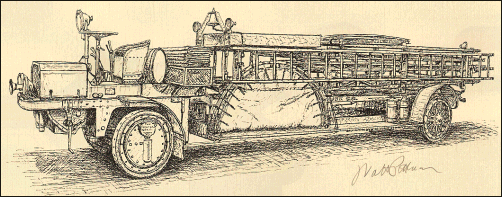August of 1910 saw the assignment of the first piece of motor fire apparatus to be purchased by the LAFD. It was a 1910 Seagrave, Model AC-53 combination chemical and hose wagon with a 4-cylinder air-cooled motor. It was assigned to Hose Co. 6 in San Pedro. Newly appointed Chief Engineer, Archie Eley was quick to recognize the benefits that the gasoline motor held for the fire service and by mid-1915, he had placed in service 23 more motor apparatus. Of these, seven were motor tractors. January 8, 1912, Chief Eley received a letter from The Seagrave Co.s' agents, The Gorham Fire Apparatus Co., requesting permission to disconnect, at no expense to the City, the AC-80 tractor from the newly delivered Seagrave City Service Truck, and Connect it to a steam engine to demonstrate the possibility of motorizing horse-drawn apparatus. The LAFD steamer fleet was in a fairly sound condition and any idea that would extend the service life of these machines at a substantial saving, greatly interested the members of the City Council. On January 15, 1912, Truck 5 was taken out of service at Engine 23's and taken to Engine 22's where Seagrave mechanics quickly disconnected the service trailer, then took the tractor to the FD shops. Steam engine No.1, an 1872 2nd Class Amoskeag was selected for the honors and the connection quickly made. On the 16th, Seagrave officials put this new combination through her paces before Chief Eley; Sup't of Engines, Price; the City Council and the Fire Commissioners and also posing for her portrait. The next day she was restored to service and would remain at Engine 22's running as Truck 5 until May, 1912. The city officials must have been impressed with what they saw because they instructed the Supply Committee to draw specifications for tractors and ask for bids. It was Seagrave that was awarded the contract for one 80 hp tractor and by mid 1913 they delivered a WC-80 4-wheeled tractor. It was attached to a 1905 2nd Class Nott Engine, s/n 685, and assigned to put Engine Co. 30 on duty September 17, 1913. Though this was the first motorized apparatus to be assigned to duty as an Engine
Company, it was not the first time a steamer was towed by an auto. When Engine Co. 26's
new Robinson "Jumbo" lost the whole lower end of its motor a couple of weeks
after going into service in February, 1912. Engine 22's new Seagrave motor combination
wagon was sent to 26's and fitted with a towing bumper and attached to Engine No.1 and
this would really be the first motorized horse-drawn apparatus of the LAFD.
|
|
The price of each of these units was $4,500. which included the initial attachment by Christie mechanics. The first was attached to steam engine no.6 at Engine 2. Late in 1913, two more Christie's were ordered and by early 1915 one was attached to steam engine no.19 at Engine 6 and the last to steam engine no.21 at Engine 22. In 1917, an attempt was made to order more of these unique tractors, but it was learned that Mr. Christie was heavily committed to building high speed gun carriages for the U.S Army and by 1918 he was unable to make deliveries of any more of his famous Christie Tractors. By this time however, over 600 of them had been built. Spec. No. 75 was again circulated among the apparatus builders, calling for bids on two more tractors. This time it was American-LaFrance with the low bid and their contract called for one, 2-wheeled tractor and one four-wheeled standard tractor. These were placed in service in October, 1918. The 2-wheeled being attached to steam engine 3's big Extra 1st Class La-France no.22. Of these nine tractors four Christie's would remain attached to their originally
assigned engines. One Christie, after its steam engine no.21 was replaced with a new motor
pumper, was removed and attached to an 1898 Seagrave City Service Truck and placed in
relief. |
|
The 1913 Seagrave served one engine and in August, 1918 was attached to Truck 1's 1910 Anderson City Service Truck. After a couple of months of relief assignments in 1922, No.73 was assigned to put Truck Co.4 on duty at Engine Co. 29 in December, 1922. In 1925 she became Truck 16 running out of Engine 20's until 1930 when she was once again placed in reserve. After WWII, she was sold to wild animal trainer Louie Gobels in Thousand Oaks. Mr. Gobels sold it to Mr. Ward Kimball in the early 50's and some years later, Mr. Kimball presented it to Travel Town where she is presently displayed. The two La-France tractors also served two apparatus assignments: The four-wheeled stayed with Truck 2's no.74 until May, 1922 when it was removed and no. 77's Seagrave tractor was attached. In September, 1922, the four-wheeled was attached to a new American La-France 85' aerial truck and retained no.74. She served as Truck 1, then Truck 10 until being replaced with a new La-France V-12 tractor in 1936. The two-wheeled tractor was removed from Engine 3's no.22 engine and used to motorize the LAFD's last horse-drawn apparatus, the 1905 Gorter Water Tower. It was returned to service motorized on October 13, 1921 as no.79. The Gorter has been beautifully restored by members of the LAFD. The chart more closely chronicles the assignments of these tractors from 1913 through 1923. In all, 16 pieces of apparatus were served by the "Nine Mechanical Horses." Information used in the preparation of this article was gathered from City Inventory
Books, City Contract Books, Company Journals, Fire Commission and City Council Minute
Books in the City Archives. Thanks also to Mort Schuman, Larry Arnold, Ray Chambers, Dale
Magee, Bob Allen and J. Edward Christie. Walt Pittman 1988 |
